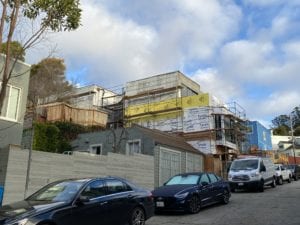San Francisco Supervisor Rafael Mandelman announces legislation to allow fourplexes on corner lots and near major transit stations and curb luxury home conversions

Photo: Bonnee Waldstein
SAN FRANCISCO — Today District 8 Supervisor Rafael Mandelman announced a pair of legislative efforts to allow fourplexes in residential neighborhoods near transit stations and on corner lots throughout the city and curb the conversion of existing housing into large luxury homes (often called “monster homes”). Mandelman will introduce an ordinance at Tuesday’s Board of Supervisors meeting targeting the proliferation of single family monster homes by requiring additional review for developments that propose adding new large single-family homes or significantly expanding existing homes without adding additional housing. Mandelman also announced an ordinance currently being drafted that will allow for up to four units on corner lots and lots within a half-mile of major transit stations in residential zoning districts, many of which currently only allow single-family homes.
“The way much of San Francisco is zoned today makes it easier to flip existing housing into monster homes than to build small apartment buildings for regular working people,” said Mandelman, who represents neighborhoods including Glen Park, Noe Valley, Diamond Heights, the Castro, Eureka Valley, Corbett Heights, Mission Dolores and Twin Peaks. “We’ve done a really good job of building housing for millionaires over the last decades, but we’ve made it much too hard to build housing for the middle class.”
The ordinance introduced Tuesday would require a Conditional Use approval in residential districts for new home construction that fails to include at least two units, or proposes to expand an existing home by more than 50 percent or beyond 2,500 square feet in size without increasing the number of units on the lot. Buildings with existing homes larger than 2,500 square feet would need to provide additional housing units or get a Conditional Use to expand by more than 10 percent. Additional units would have to be at least one-third the size of larger units to encourage development of mid-sized housing.
“I see a constant stream of 1,200 or 1,500 square foot older, relatively affordable homes in neighborhoods like Noe Valley and Glen Park being converted into 5,000 square foot mega mansions that flip for $6 or $7 million,” he said. “If you’re going to be building 5,000 square feet, we’re better off as a city seeing two, three, or four units in that building.”
Mandelman also announced that he is drafting an ordinance that would allow for up to four units of housing on corner lots and lots within a half-mile from a major rail station in residential (RH) zoning districts. Rail stations with faregates and paid platform areas would count, including the Glen Park and Balboa Park BART stations, and Muni stations at Castro, Church, West Portal, and Forest Hill. The ordinance would apply to corner lots in RH districts citywide. The ordinance would not include any changes to current height, bulk, or design controls.
“We should be making it easier to build housing for families in neighborhoods across the city, especially where there is good access to parks, schools, and healthy food as well as strong transit options and access to jobs,” he said. “We’ve concentrated most of our recent development in just a few places, and this is a way for every neighborhood to do its part, including neighborhoods in my district.”
San Francisco has zoned for thousands of units of new multi-family housing since the 2008 recession, almost entirely concentrated in mid to large mixed-use developments on the city’s east side in neighborhoods like SOMA, Mission Bay, Bayview, and the Mission. Still, roughly three-quarters of the city – mostly in the central and westside neighborhoods – remains designated for “residential house” or RH zoning that allows a maximum of one, two, or three units per lot, and is largely reserved for single-family homes.
Mandelman also noted that the City’s existing controls on residential demolitions and eviction protections would apply, and that the large residence ordinance is designed to cover many major alteration projects that often amount to the de facto demolition of existing housing, but don’t trigger additional review under current policies. The ordinance would also require additional review for major expansions of buildings that are designated as historic.
The large residence ordinance will be introduced on February 2 and will be reviewed by the Planning Commission before being considered by the Board of Supervisors. The fourplex proposal is being prepared for introduction in the coming weeks and will require environmental review before it can be approved.
Jacob Bintliff
Legislative Aide
Office of Supervisor Rafael Mandelman
City Hall, 1 Dr. Carlton B. Goodlett Place, Room 284
San Francisco, California 94102